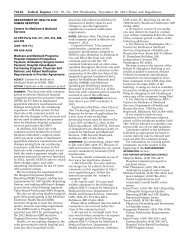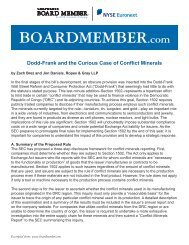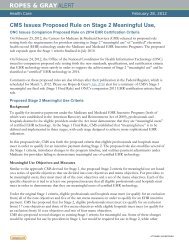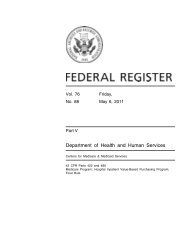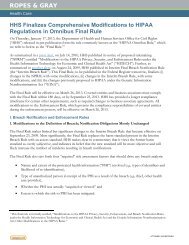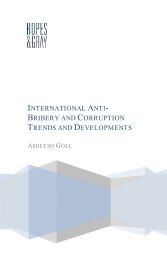SCOTT A. JALOWAYSKI - Ropes & Gray
SCOTT A. JALOWAYSKI - Ropes & Gray
SCOTT A. JALOWAYSKI - Ropes & Gray
Create successful ePaper yourself
Turn your PDF publications into a flip-book with our unique Google optimized e-Paper software.
1May 16, 2011“It is difficult to structure and execute a traditional leveragebuyout deal in PRC.”<strong>SCOTT</strong> A. <strong>JALOWAYSKI</strong>Partner<strong>Ropes</strong> & <strong>Gray</strong>, LLPScott Jalowayski shared insights with Global M&A Network about thedominance of China in the Asia-Pacific M&A stage, the latest buyouttheme of 'homecomings', the dynamics of RMB versus foreign fundsallocation, legal nuances for navigating through PRC regulations alongwith his views on competition heating up between the on-shore and offshoreplayers for deals in the coming months.Q: What trends are driving cross-border merger and acquisition transactions in the wider Asia Pacific regions today?Mr. Jalowayski: The clearest cross-border trends involve China, Africa and Southeast Asia. Tremendous liquidityworldwide especially from the US monetary policy is also having an impact. Yet, the China growth story continues todominate both private equity and strategic M&A. Strategics worldwide are eager to expand and are looking foropportunities in China. A recent strategic example includes purchase of Feixiang Chemicals by Rhodia SA (France).Our team advised Bain Capital on the sale.Also, China's thirst for natural resources as well as competition in the global natural resources industries aresignificantly influencing Asia-Pacific M&A. Examples include the Rio Tinto (UK) takeover of Riversdale (Australia)with coking coal deposits in Mozambique, and China Minmetals recent bid for Equinox Minerals and its copperassets in Zambia.Q: What are the most common leverage buyout themes this year compared to last year?Mr. Jalowayski: I think we will continue to see an increase in leverage Ebitda multiples and a decrease in equitycontribution levels as liquidity improves and more funds are raised. For example, in early 2010 Australia was averagingabout 3 - 3.5 turns of Ebitda whereas by Q4 2010 that number had risen to 4 to 4.5 turns. In addition, a very commontheme these days is 'homecomings'. Asian and global funds are seeking opportunities to take private Chinesebusinesses that are listed on an exchange outside of China (such as the Singapore Stock Exchange, NYSE or Nasdaq);and then relist them in Hong Kong or on a mainland Chinese exchange. Other themes include the rapid development ofthe private equity industry in Asia, and the second generation of sponsors and fundraising that is taking place regionallyand worldwide.Q: Can you elaborate on the “homecomings”? Is this a take-private transaction and then a re-listing?Mr. Jalowayski: Yes, these are public-to-private deals which generally envision a later exit in an IPO on an exchangewhere investors are better positioned to understand the true value. So, for Chinese businesses, that can mean the HongKong Stock Exchange or an exchange in PRC. Returns are driven by higher valuations given to such businesses on reexit,as well as private equity's ability to leverage expertise to grow the business when it is a private concern--i.e., priorto the re-listing or sale.The process varies significantly depending on the jurisdiction in which the company is currently listed as well as thejurisdiction in which the company is incorporated. This will determine the directors' duties in the private takeovercontext, as well as the rules governing takeovers. In the US, the process is driven fundamentally by state law relating tofiduciary duties of the directors, as well as the Exchange Act of 1934. The former is what governs how the directorsmust act in the best interest of shareholders when considering a sale, and the latter governs the rules regardingacquisitions of listed companies.Reprinted by permission from dealmaker SPOT•LIGHT©. Published weekly on-line www.globalmanetwork.com
May 16, 2011Q: In your observation, what regions are attracting private equity investments in Asia today?Mr. Jalowayski: China continues to attract a tremendous amount of capital. Funds are also actively looking atVietnam. A recent example of this is KKR investment in Masan Consumer. Japan continues to be an attractivemarket for private equity funds that have deep operating company and industry experience because of privateequity's skill in rationalizing businesses and creating value.Q: What are the macro trends in the antitrust approvals in China?Mr. Jalowayski: The Anti-Monopoly Law clearance mechanism contemplates an initial 30-day review period withinwhich concentrations that pose no substantive antitrust concern should be cleared. However, what is happening isthat in practice even concentrations that pose little substantive antitrust issues are being pushed into a 2nd phaseof review, which extends the review period for up to an additional 90 days. This is believed to relate primarily tothe volume of filings relative to the manpower resources in Ministry of Commerce PRC (MOFCOM) rather thanincreased scrutiny of transactions on MOFCOM's part, but it nonetheless has the potential to delay closings inPRC M&A transactions.Q: From a legal perspective, what are the risks for managing in-bound transactions in China?Mr. Jalowayski: From an acquirer's perspective the overall risks are very similar for private equity and strategicacquirers and this is a result of PRC government attitudes becoming more favorable towards private equityinvestors. On a marco-level, corruption is an on-going issue in high-risk jurisdictions such as China and India. It isno secret that China is a difficult environment for doing due diligence on companies. The recent revelationsregarding China Forestry underscore the risk. So I would say that simple business fraud is the single biggest risk.These factors together with the US Department of Justice's focus on PE Funds and certain industries in China(such as pharma, distribution) contribute to significant risks that require planning.Q: How can private equity firms plan for pre- and post acquisition?Mr. Jalowayski: Pre-investment, buyers need to carry out robust, thoughtful and targeted legal due diligence andinstitutionalize an appropriate level of checks and balances to dispassionately assess the risks of potential deals.Post-investment, FCPA (Foreign Corrupt Practices Act) and anti-corruption policies and procedures need to bedeveloped and implemented. In the case of PE funds, the nature of such policies and procedures may varydepending on factors such as the specific industry the target operates in and the degree of the fund's control overthe target's operations and governance.Q: What are the chief obstacles faced by private equity firms in acquiring assets in China today?Mr. Jalowayski: For foreign PE houses, the PRC's limitations on foreign exchange, which, together with limitationsin the existing PRC Company Law, make it difficult to effectively push down offshore leveraged financing to a PRCoperating company. This remains the most difficult challenge faced by PE firms in acquiring PRC assets. Assetscan technically be acquired but without being able to add leverage to increase returns, the investment propositionbecomes potentially unattractive. It is one of the themes driving the push towards Renminbi (RMB) funds, and oneof the reasons for growth equity activity in the form of minority stakes.Q: What is the nature of ownership structures that technically constitutes a buyout vs. a minority stake? How doesPRC compare with other Asian markets?Mr. Jalowayski: In a leverage buyout, a holding company owned by a PE fund purchases an operating company.The funds used to purchase the operating company come from equity contributions by the fund as well as debtfinancing from banks. Following the purchase of the target, the PE backed holding company is usually merged intothe operating company so that the operating company effectively becomes the borrower and cash generated fromthe opco's business is used to repay the debt. This deal structure isn't possible in the PRC, and it is alsoextremely difficult for an onshore subsidiary to guarantee an offshore holding company's debt. So, it is difficult tostructure and execute a traditional LBO deal in the PRC because banks are generally reluctant to lend to entitiesthat do not own the assets of the business. The legal framework in many other jurisdictions in Asia enables LBOstructures including Japan, Korea and Taiwan--though each has its own level of complexities. Generally speaking,minority investments or "buy-ins" are smaller and typically do not use leverage, hence are easier to execute.Reprinted by permission from dealmaker SPOT•LIGHT©. Published weekly on-line www.globalmanetwork.com
May 16, 2011Q: There has been a large number of "Asian" funds raised by the global fund community. Are these funds fullydeployed, and what's the affect on competition, valuations?Mr. Jalowayski: Generally speaking the funds have been deployed or the investment period of the pre-08 funds isrunning out. Many regional and global funds are out raising new funds, plus there are a number of new sponsors inthe market raising funds for the first time. The funds that are being raised include both dollar and RMB-denominatedfunds, of course. As I mentioned before, the loose US monetary policy together with the number of new funds, andreturn of liquidity continues to drive valuations and competition for good assets in the region. I think we will continue tosee valuations go up in the near term.Q: Can you expand on how the competition is playing out among different players for PRC deals and who benefits?Mr. Jalowayski: In the PRC, we have seen many assets go to onshore strategics simply because they will likely nothave to go through any approval process. This vastly increases the certainty of the transaction and can accelerate thetimeline. So one can imagine onshore strategics are extremely attractive to the sellers. This is by far the mostcommon competitive issue between PRC funds and strategics vs. offshore acquirers.As for the competition between strategics vs. funds (whether onshore or offshore), the dynamic is similar to the rest ofthe world: when leverage levels were lower, strategics had a distinct advantage because they could (and did) paymore for assets. With leverage levels rising, private equity funds may be able to stretch a bit more on price so Iexpect competition to heat up.Q: What are the legal considerations for RMB funds for sponsors? What are the dynamics between the RMB vs.foreign funds?Mr. Jalowayski: Sponsors raising RMB funds face a whole host of complicated issues and so it is imperative to haveboth local and international counsel involved early. The issues range from navigating a nascent legal framework inPRC to complicated cross-border tax structuring and include a number of other international issues such asrationalizing fund terms and of course, dealing with the dynamics between RMB funds and foreign funds from thesame sponsors.On the latter point, the dynamics are fairly complicated. There is a tension on the sponsor side to be able to controlthe allocation because the decision may impact deal execution and the speed with which a transaction can becompleted. Limited partners on the other hand--particularly offshore LP's, want to be assured that the offshore fundwill be afforded its fair share of deal allocation.Q: Shifting to Japan, what are your thoughts about private equity investing themes in light of the devastating crisis?Do you foresee opportunities being created by reconstruction efforts over the next few years?Mr. Jalowayski: I think broad themes have not changed. Japan represents an incredible yet exceedingly difficultopportunity for PE funds. In Japan the primary way to drive value is from operational efficiencies and industryinnovation since neither pure growth nor cheap assets are drivers of high return. There is however certainty since allof the enabling commercial legislation to affect private equity deals has been put in place over the last decade andthis reduces ambiguity and risks.I am hopeful that the theme that emerges from the reconstruction and healing efforts is an embracing of the politicalreform necessary to kick-start the rationalization process for the broader economy-including measures that incentivizebusiness owners to put assets in the hands of those that can create more value for shareholders.Q: In your experience, how do you advise your private equity clients on IPO exit options? For example what’s thedifference between ShangPharma versus the NT Pharma offering?Mr. Jalowayski: Structuring flexibility is important. It often is not clear what exchange will make the most sense, or forthat matter whether an IPO is an appropriate exit at all. For ShangPharma, which listed on the NYSE, and NTPharma, which listed on the Hong Kong Stock Exchange, the exit processes were very different. In a nutshell, the USSEC registration process is a disclosure-based system whereas the Hong Kong system is a merit-based reviewsystem. The systems are very different, but suffice it to say that they are not equally flexible. So, it is critical to haveboth private equity and cap markets structuring advice early on in the go-in to make sure an IPO on either exchangeis not foreclosed or made exceedingly difficult.Reprinted by permission from dealmaker SPOT•LIGHT©. Published weekly on-line www.globalmanetwork.com
May 16, 2011Q: What differentiates the Asia team at <strong>Ropes</strong> & <strong>Gray</strong> in the deal making process?Mr. Jalowayski: Our focus on the private equity industry worldwide, our depth of service offering in the region andour ability to collaborate sets us apart. In Hong Kong, we have a seasoned group of partners with M&A, FundStructuring, Debt Finance, Real Estate and Fund Compliance expertise. We bring local language skills and on-thegroundpresence to service our clients from the global fund industries.Q: On a personal note, what book are you reading?Mr. Jalowayski: I am currently reading the Bullpen Gospels by Dirk Hayhurst. Though I've lived in Asia for morethan a decade, I'm still a baseball fan at heart.Reprinted by permission from dealmaker SPOT•LIGHT©. Published weekly on-line www.globalmanetwork.com




